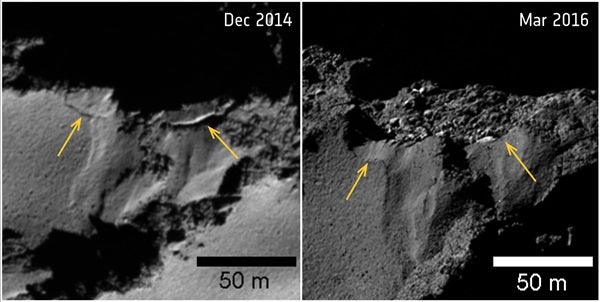Comets are icy, rocky bodies that spend most of their time in the outer solar system on highly elliptical orbits that take tens, hundreds, or thousands of years to complete. Far from the Sun, temperatures are too cold for water to exist as a liquid or gas, so comets carry their water (and other volatiles, such as carbon dioxide and methanol) as ices. When a comet’s orbit brings it close to the Sun, the temperature rises and these ices begin to sublimate, transforming from a solid directly into a gas and helping to form the comet’s signature tail.
But the formation of this breathtaking feature can spell big changes for the surface of the comet. “This is something we were not able to really appreciate before the Rosetta mission, which gave us the chance to look at a comet in ultra-high resolution for more than two years,” says Ramy El-Maarry of the University of Colorado, Boulder, in a press release associated with the publication of a new study in the journal Science on March 21. El-Maarry is a member of the U.S. Rosetta science team and the first author of the paper, which is based on data taken while Rosetta orbited comet 67P/Churyumov-Gerasimenko from August 2014 through September 2016.
During this time, comet 67P made its way through the inner solar system; as the comet warmed, Rosetta recorded substantial changes occurring on the surface. “We saw a massive cliff collapse and a large crack in the neck of the comet get bigger and bigger,” says El-Maarry. The crack, which occurred in the slimmest part of the dog bone-shaped comet, was identified in August 2014 and initially extended about 1,600 feet (500 meters). By December of the same year, the crack had widened by about 100 feet (30m); by June 2016, a new fracture had appeared, running parallel to the first and spanning between 500 and 1,000 feet (150-300m).
Because of its location at the comet’s smaller, structurally weaker neck, El-Maarry believes it may one day split the comet in two. The crack is believed to have occurred as the comet’s rotational rate around its axis sped up due to heating by the Sun.
Other changes that Rosetta recorded include the relocation of a 282 million-pound (130 million kilograms) boulder to a new spot 460 feet (140m) away. The study speculates that the boulder’s movement is likely due to the several outburst events the spacecraft recorded as originating near the massive rock’s original location. The collapse of a cliff on the comet’s nucleus, which occurred in July 2015, is outlined in a second paper, also published on March 21, in Nature Astronomy. The cliff’s collapse was also likely due to an outburst of gas and dust that encompassed the area; in the wake of the collapse, Rosetta was able to peer briefly beneath the dusty surface of the comet to spot the pristine water ice preserved below.
These observations are the first such high-quality records of the processes that take place on comets as they approach the Sun. According to El-Maarry, such observations allow astronomers to better understand the processes that shape comets and the timescales over which they occur. This makes it possible to work backwards and make better inferences about the conditions in the early solar nebula, which are preserved within the interiors of such icy, distant objects.










